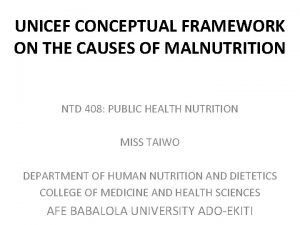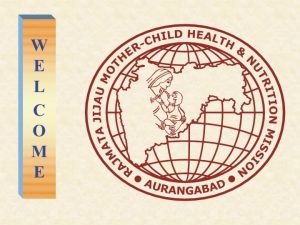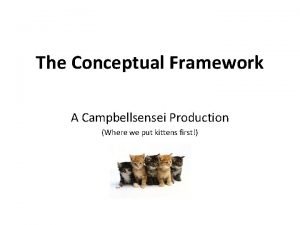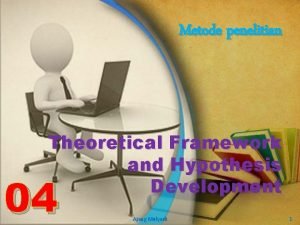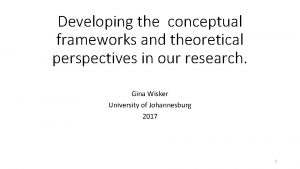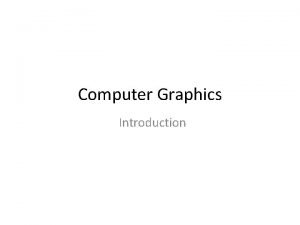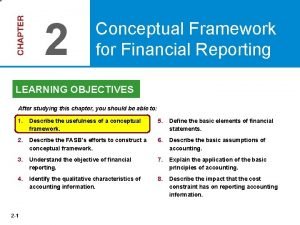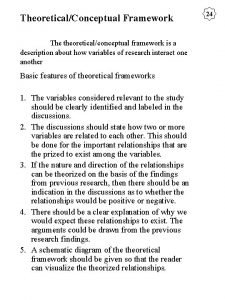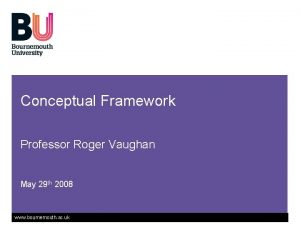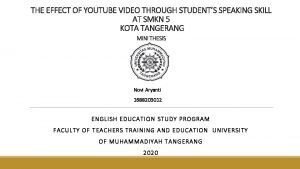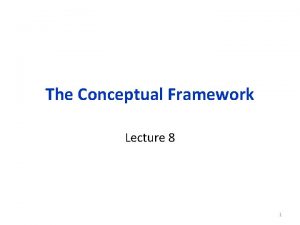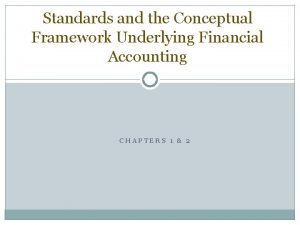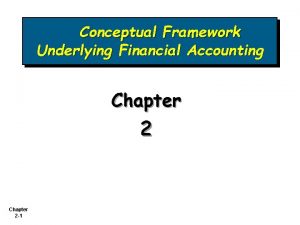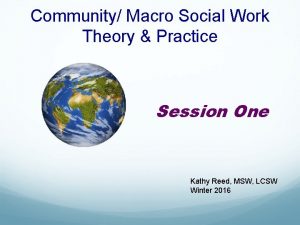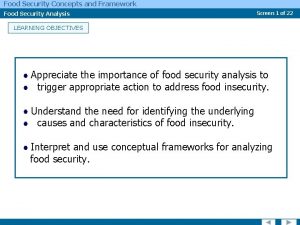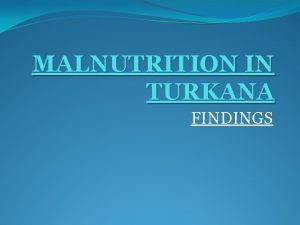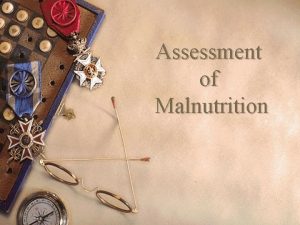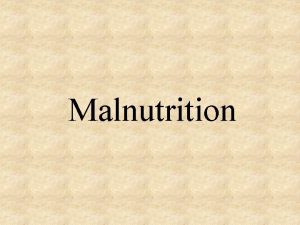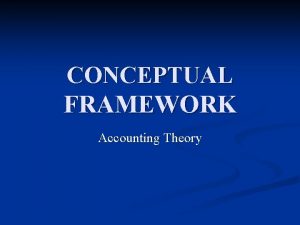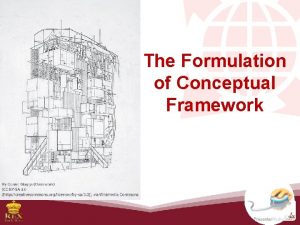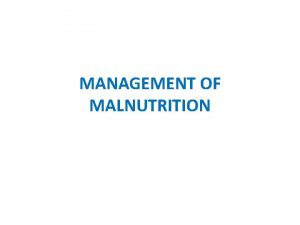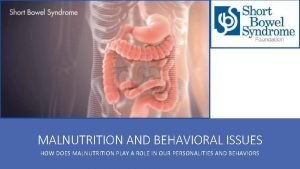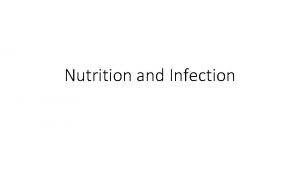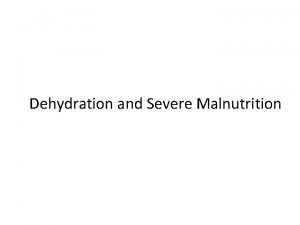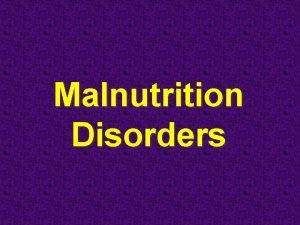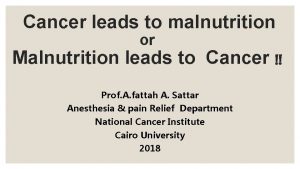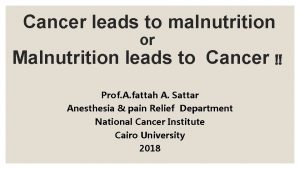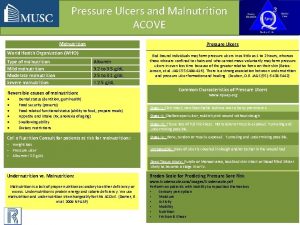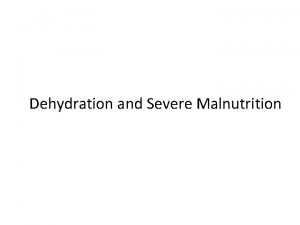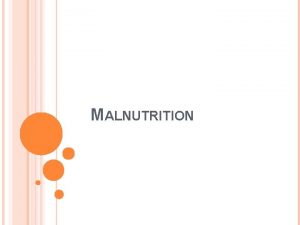Conceptual Framework of the causes of malnutrition Malnutrition




























- Slides: 28


Conceptual Framework of the causes of malnutrition Malnutrition and death Outcomes Inadequate dietary intake Inadequate access to food Disease Inadequate care for mothers and children Insufficient health services and unhealthy environment Immediate causes Underlying Causes Inadequate education Formal and nonformal institutions Political and ideological superstructure Economic structure Source : UNICEF (1990) Potential resources Basic Causes

% of underweight children under age 3 NFHS -2 revealed that 50% children were malnourished in Maharashtra Child malnutrition in selected Indian states 75 56 55 50 51 46 48 Maharashtra Gujarat India 25 0 M. P. Bihar Source: NFHS-2, 1998 -99 But regular data gave no indication as it was never analyzed

INITIATIVES UNDERTAKEN IN AURANGABAD DIVISION • Focus on three issues: survey, weighing, gradation • Stress on full coverage (100% as level for survey efficiency and 95% as acceptable lower limit for weighing efficiency) • Special focus on Grade III/IV reduction • Regular medical examination • Fact finding, not fault finding • Local initiative in nutrition/health measures • Involvement of community, especially PRIs, mothers’ groups

Survey Efficiency - Dec. 01 -July 02 -Feb 06 Fig. in lakhs Sr. No District Rural Population Census 01 Population of 0 to 6 age group Census 01 1 ICDS Survey No. of 0 to 6 children. Dec. 01 ICDS Survey No. of 0 to 6 children. July 02 ICDS Survey No. of 0 to 6 children. Feb 06 Aurangabad 18. 10 2. 99 2. 10 2. 28 2. 67 2 Jalna 13. 05 2. 13 1. 07 1. 63 2. 04 3 Parbhani 10. 43 1. 76 0. 24 1. 57 1. 68 4 Hingoli 8. 33 1. 42 0. 90 0. 97 1. 34 5 Nanded 21. 87 3. 69 2. 85 2. 57 3. 08 6 Beed 17. 74 2. 78 2. 38 2. 42 2. 76 7 Latur 15. 90 2. 52 1. 88 1. 90 2. 34 8 Osmanabad 12. 53 1. 89 1. 48 1. 50 1. 63 Total 117. 95 19. 18 12. 90 14. 84 17. 55

Percentage & Number of Weighed children against Census 2001 0 -6 Children Districts Dec. 02 Dec. 04 Number Feb. 06 Number % % Number % Aurangabad 1. 58 52. 84 2. 64 88. 29 2. 56 95. 62 Jalna 0. 85 39. 91 2. 05 96. 24 1. 95 91. 55 Parbhani 0. 17 9. 66 1. 55 88. 07 1. 63 92. 61 Hingoli 0. 5 35. 21 1. 32 92. 96 1. 31 92. 25 Nanded 2. 35 63. 69 3. 13 84. 82 2. 94 79. 67 Beed 1. 7 61. 15 2. 58 92. 81 2. 39 85. 97 Latur 1. 62 64. 29 2. 36 93. 65 2. 25 89. 29 Osmanabad 1. 21 64. 02 1. 75 92. 59 1. 56 82. 54 Total 9. 98 52. 03 17. 38 90. 62 16. 58 86. 44

Percentage of Gr. II Children against weighed children Districts Dec. 02 Number Dec. 04 % Number Feb. 06 % Number % Aurangabad 40745 16. 24 34280 13. 00 5841 2. 28 Jalna 29157 17. 92 28622 13. 97 4737 2. 43 Parbhani 22868 17. 78 21346 13. 75 3081 1. 89 Hingoli 21151 18. 00 20370 15. 42 4620 3. 54 Nanded 50495 18. 65 46137 14. 76 5618 1. 91 Beed 26718 10. 45 21295 8. 25 6132 2. 56 Latur 26726 11. 72 20121 8. 52 6211 2. 76 Osmanabad 17400 10. 73 6848 3. 91 2368 1. 52 235270 14. 93 199019 11. 45 38608 2. 33 Total

Number of Gr. III+IV children Year wise trend District Dec. 01 July 02 Dec. 03 Dec. 04 Dec. 05 Feb. 06 Auangabad 1772 2278 1654 1210 403 11 33 Jalna 930 1306 1043 659 249 200 142 Parbhani 191 1444 920 490 140 43 17 Hingoli 136 555 404 150 112 56 33 Nanded 1629 1081 824 365 51 91 42 Beed 841 1448 645 437 141 175 132 Latur 1511 1324 845 443 155 121 108 Osmanabad 957 1269 679 170 0 7867 10705 7014 3924 1251 697 507 Total




Malnutrition Removal – Star Competition No. Of Stars Criteria Anganwadi Centres/PHCs/blocks/districts which do not have any Grade IV child Anganwadi Centres/PHCs/blocks/districts which do not have any Grade III or Grade IV child Anganwadi Centres/PHCs/blocks/districts which do not have any Grade II, III or IV child Anganwadi Centres/PHCs/blocks/districts which do not have any Grade I, II, III or IV child & in which jurisdiction there is no mother below the age of 19 years

Outcomes of the Marathwada Initiative • • Motivation and enthusiasm in the ICDS machinery Involvement of many Medical Officers Significant local involvement in initiatives Problem-solving approach Social audit of children Substantial reduction in Grade III/IV malnutrition Replication across the State of Maharashtra

Food for thought “ With our resources and the money we spend we could easily accomplish three times what we do, in half the time we normally take, if we were to operate in mission mode with a vision for the nation. ” » -- APJ Abdul Kalam in Ignited Minds

Rajmata Jijau Mother-Child Health & Nutrition Mission • One of the State’s top priorities: malnutrition removal as a MISSION • State-level Steering Committee headed by Chief Minister • Monitoring & Implementation Committee headed by Minister (W&CD) • Advisory Committee under Chief Secretary • Establishment of State Malnutrition Removal Mission Unit • Funding of Unit & programmes through Central/State budget as well as multilateral/bilateral funding sources

Objectives of the Mission • Reduction in Grade 3 & 4 malnutrition in 0 -6 age group • Special focus on health, nutrition and immunisation aspects in 0 -3 age group • Reduction in Grade 1 & 2 malnutrition in 0 -6 age group • Newborn care initiatives • Antenatal, perinatal and postnatal care for mothers • Focus on pre-teen/adolescent girls: nutrition and health education • Transfer of the management function to the community

State Malnutrition Removal Mission Unit Functions • Coordination of activities of different departments • Monitoring of key indicators to ensure adherence to Mission targets • Capacity-building in different departments to make the programme self-sustainable • Making the initiative community-driven over time Composition • Secretary level IAS officer ……. . . Director General • Addl. CEO rank officer ……. . Director (Training) • Addl. CEO rank officer ……. Director (Monitoring) • DHO rank officer ……. Deputy Director (Health) • CDPO rank officer …… Assistant Director (Child Development)

Phases of the Mission Phase-III

Inputs Processes Outcomes

Focus Areas of Mission • • • Antenatal care Feeding practices Complete immunisation Deworming Micronutrient supplementation Nutrition/health education

Key Activities of Mission • Training & Motivation q Sensitization q Problem-solving • Coordination q Between departments, esp. ICDS/Health q Effective budget utilization • Monitoring & Evaluation q Ensuring accountability q Informed policy decisions Information, Education, Communication q Behavioural change q Community initiatives to evolve local solutions


Some Issues for Thought • Still too much focus on food, too little on improving child-care behaviour, family nutrition patterns • Children in 0 -3 age group and from disadvantaged groups not served adequately by existing ICDS • Lack of clear policy focus on areas with greatest levels of malnutrition

The Bhavishya Alliance Objective Elimination of child malnutrition in India

The Bhavishya Alliance Emphasis on Ø Human change, relationships & partnerships (personal/interpersonal/systemic) Ø Shared understanding of malnutrition in a holistic framework Ø Interaction between actors concerned with malnutrition, especially the communities to be served Ø Passion, commitment, orientation to action

The Bhavishya Alliance • Change Lab Ø One/two participants from each member organisation (government, corporates, NGOs/CBOs) Ø Shared understanding of current reality Ø Prototyping initiatives Ø Implementing pilot projects

What partnership model do we aim for? • • • Sustainable over time Replicable across states of India Win-win situation for all Built on trust Focused on outcomes Strong community links

THANK YOU
 Conceptual framework of malnutrition
Conceptual framework of malnutrition Conceptual framework for malnutrition
Conceptual framework for malnutrition Conceptual vs theoretical framework
Conceptual vs theoretical framework Conceptual framework
Conceptual framework Theoretical framework
Theoretical framework Theoretical framework
Theoretical framework Proximate and ultimate causes of behaviour
Proximate and ultimate causes of behaviour Proximate causation vs ultimate causation
Proximate causation vs ultimate causation Conceptual framework art
Conceptual framework art Conceptual framework in research input process output
Conceptual framework in research input process output Hypothesis development adalah
Hypothesis development adalah Tracer study conceptual framework
Tracer study conceptual framework Explain iot conceptual and architectural framework
Explain iot conceptual and architectural framework Conceptual and theoretical framework
Conceptual and theoretical framework Calligraphic refresh graphics display
Calligraphic refresh graphics display Conceptual framework of iasb and fasb
Conceptual framework of iasb and fasb The underlying theme of the conceptual framework is
The underlying theme of the conceptual framework is Conceptual framework of financial accounting
Conceptual framework of financial accounting Conceptual framework schematic diagram
Conceptual framework schematic diagram Isometric perspective art definition
Isometric perspective art definition How to make conceptual framework
How to make conceptual framework Youtube
Youtube Source of conceptual framework
Source of conceptual framework Assumptions of conceptual framework
Assumptions of conceptual framework The conceptual framework that underlies ifrs
The conceptual framework that underlies ifrs Fair value historical cost
Fair value historical cost Macro practice conceptual framework
Macro practice conceptual framework What is conceptual framework of science education
What is conceptual framework of science education Food secutiry
Food secutiry
